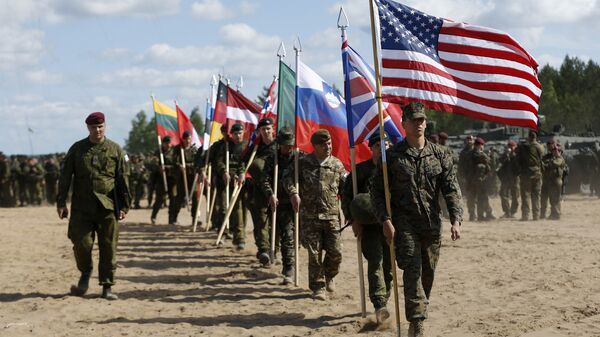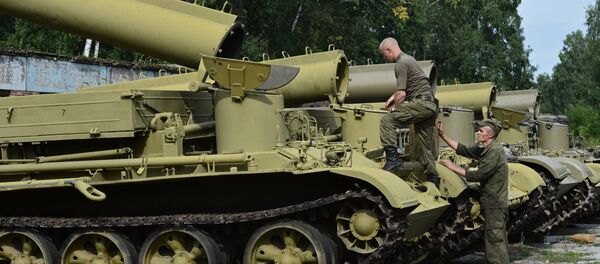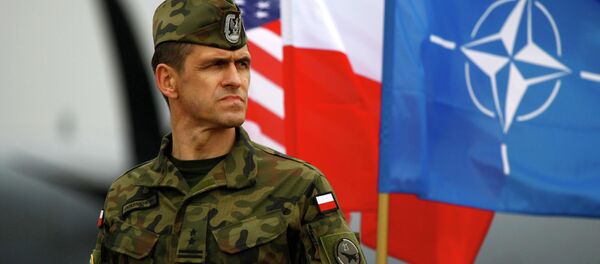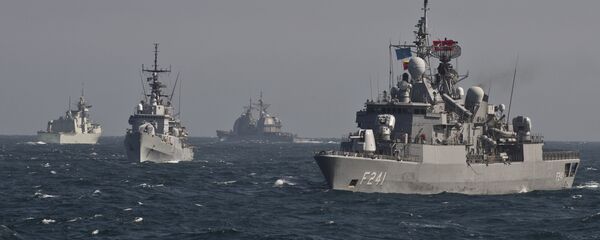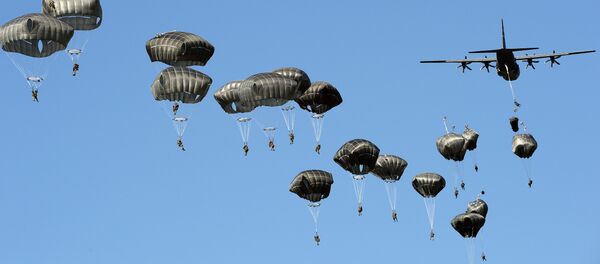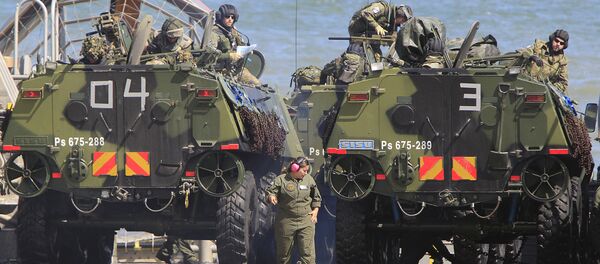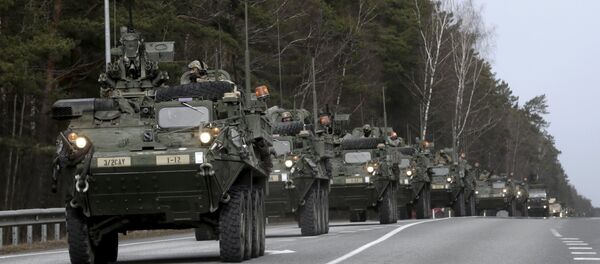NATO has its strongest military alignment on the borders with Russia
A “myth” that “NATO is trying to encircle Russia” tops the list. The key argument against such a perception by Moscow is the “facts of geography.”
“Russia’s land border is just over 20,000 kilometers long. Of that, 1,215 kilometers, or less than one-sixteenth, face current NATO members,” the document says.
“Claims that NATO is building bases around Russia are similarly groundless,” it further adds.
However Viktor Murakhovsky, a retired Russian army colonel who is now the editor of the Arsenal Otechestva (the Armory of the Fatherland) military magazine calls the argument “absolute demagogy” and recalls that during the years of the Second World War the length of the Soviet-German front contour was commensurable and varied between 1,200 and 1,500 km depending on the timeframe of the conflict.
“The USSR had experienced the heaviest losses in human lives, infrastructure and so on alongside this front even though it is insignificant compared to its total land border,” the military expert said in an interview with Russian news website Vzglyad.
“It is at our western borders with NATO member states where the alliance has built up its strongest military alignment,” the expert notes.
With regards to the second part of the argument, the website notes that upon its collapse in 1991, the Soviet Union had a common border with only three NATO member states: Norway (219 km), Turkey (about 600 km) and the US (Bering Strait maritime border, less than 50 km).
However one glance at the present day map of NATO member and partner countries is enough to see that they have solid coverage across adjoining territories of the CIS and with the potential accession of Finland into the alliance, the total length of a common border will considerably increase.
The distance between NATO member state Estonia and Russia’s city of St. Petersburg is only about 135 km. The Russian exclave of Kaliningrad, as it is clearly seen on the map, is separated from Russia’s mainland by two NATO states, Lithuania and Poland, which will soon host the next NATO summit, with an aim of abandoning the Founding Act on Mutual Relations between Russia and the alliance.
NATO needs this confrontation to justify its mere existence
Next on the list is the “myth” that “NATO tried to isolate or marginalize Russia.” The key argument is that “since the early 1990s, the Alliance has consistently worked to build a cooperative relationship with Russia on areas of mutual interest.”
And it was “Russia’s aggressive actions against Ukraine” back in March 2014, which forced the alliance to suspended practical cooperation with Russia.
However Kirill Koktysh, an associate professor of Political Science at Moscow State University of International Relations (MGIMO) reminded Vzglyad that NATO was set up with one purpose — to confront the Soviet Union. Hence institutionally it is a regional organization set up and aimed for confrontation with the USSR and now Russia.
“Thus there is good reason to wonder throughout the whole period after the collapse of the USSR what the purpose for the existence of the alliance is nowadays,” he told the website.
The alliance has reached its goal and the bloc is no longer needed. Nevertheless, the alliance is kept afloat, he added.
“Since the reunification of Russia with Crimea, NATO has seen the chance to survive and it needs this confrontation to justify its mere existence,” the political analyst concluded.
Land-based component Aegis Ashore could launch not only interceptors but cruise missiles with nuclear warheads
The third on the list is the “myth” that “NATO missile defense targets Russia and the Iran agreement proves it.”
The key argument is that “geography and physics make it impossible for the NATO system to shoot down Russian intercontinental missiles from NATO sites in Romania or Poland. The interceptors are too few, and located too far south or too close to Russia, to be able to do so. They are designed to tackle threats from outside the Euro-Atlantic area.”
And that “the Iranian agreement does not cover the proliferation of ballistic-missile technology which is an issue completely different from nuclear questions.”
However Viktor Murakhovsky reminds that Russia has repeatedly voiced its concerns not over the possible counteraction against its intercontinental missiles but over the violations of the 1987 Intermediate-Range Nuclear Forces (INF) Treaty between Russia and the US on elimination of their intermediate-range and shorter-range missiles.
What it means, the military expert explained, is that Russia has no control over these launchers. Their owners could easily install both Standard Missile (SM) interceptors or Tomahawk cruise missiles, which could also carry a nuclear warhead. There is no technical barrier and it could be done within minutes.
The second concern is that currently SMs are unable to intercept Russian intercontinental missiles, however the program is under constant development and there could be time when they will be able to do so. However there are no restrictions agreed upon between Russia and the US, as Washington unilaterally withdrew from the Anti-Ballistic Missile (ABM) Treaty back in 2002.
Thus, Murakhovsky said, there is nothing limiting the development of these systems apart from the “financial wants and wishes” of the US Congress.
With regards to Iran, the expert noted that its ballistic missiles could pose a threat to Europe only on conditions that it carries a nuclear warhead.
However, he said, “this topic has been closed” with the recent nuclear agreement and its conventional warheads pose no threat to the European continent.
The fourth “myth” is that “NATO exercises are a provocation which threatens Russia.”
The key argument is that “every nation has the right to conduct exercises, as long as they do so within their international obligations, including notifying the actual numbers and providing observation opportunities when required.”
However Murakhovsky refuted that NATO just uses the exercise and all the “chatter in the mass media about these exercises” as a cover up for its real actions on the continent.
Russia’s main concern, he said, is not the exercises but the deployment of NATO permanent contingents on its borders, which formally does not fall within the set agreements between Russia and the alliance, as the latter claims it is on a rotation basis.
“Yes, today they have Polish jet fighters there, tomorrow there are Danish, the next day – German,” the military expert says.
Formally, he explained, there is seemingly no violation. However, from the opponent’s point of view, and that is Russia, there is a permanent contingent on NATO air bases in the Baltic States.
The number of NATO jet fighters is constant. It is always 16 – today, tomorrow and the next day. And it is absolutely insignificant from the military point which country they belong to or how often they rotate, he said.
Anf, finally, it has nothing to do with democracy
And the final “myth” is that “NATO’s Open Door policy creates new dividing lines in Europe and deepens existing ones.”
However the website cites the recent remarks of Lithuanian President Dalia Grybauskaitė, who recently called for a clearer split between the East and the West and noted that the calls for possible cooperation with the Eastern countries are “dangerous.”
The outlet also recalls the remarks of former president of the European Commission Jose Manuel Barroso who back in 2011 told then Ukrainian president Yanukovich that Ukraine could not integrate into the free trade zone with the EU and the Customs Union with Russia, Belarus and Kazakhstan at the same time.
The website says that the remark illustrates that the western leaders have no intention of smoothing over the differences between the East and the West.
It also quotes Kirill Koktysh as explaining that political science has identified over ten different models of democracy however the US admits only one of them – a procedural democracy and tries to push it globally.
By doing it, the political analyst noted, the US tries to manipulate the internal policies of different states.
There is no secret, he explained, that the elections always require bringing in considerable resources and the control over these resources allow to concentrate them with the necessary politicians. And that was exactly the purpose of post-war system which was set up with the help of the US.
Thus it increased the controllability and degree of influence on the European countries. However it has a little to do with democracy.

